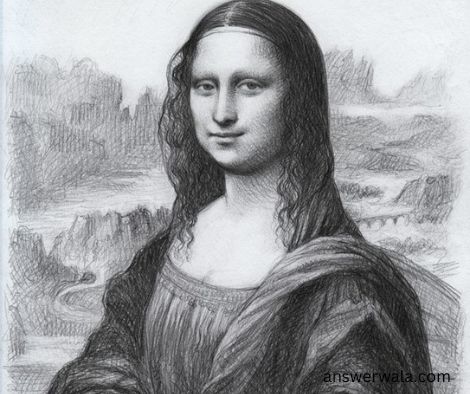MONALISA, a live painting by Leonardo da Vinci – answerwala explains !!!
READ the full article in your language, select HINDI / Marathi / Gujrati / Tamil from Top Right button.
Who was MONALISA
The Mona Lisa, also known as La Gioconda or La Joconde, is a portrait painting believed to depict Lisa Gherardini, the wife of Florentine merchant Francesco del Giocondo. The painting is commonly attributed to the Italian Renaissance artist Leonardo da Vinci and is thought to have been created between 1503 and 1506, although there is some debate about the exact dates.
Lisa Gherardini, born in 1479, was a woman from Florence, Italy. She married Francesco del Giocondo in 1495 when she was 16 years old. The identity of the woman in the painting as Lisa del Giocondo gained support through historical records, including notes from the 16th-century art historian Giorgio Vasari, who mentioned the Mona Lisa as a portrait of Lisa del Giocondo.
The subject’s enigmatic smile and the skillful techniques employed by Leonardo da Vinci in the painting have contributed to its fame and mystique. The Mona Lisa is housed in the Louvre Museum in Paris and is one of the most celebrated and recognized artworks in the world.
The Portrait
The Mona Lisa is a famous portrait painting created by the Italian Renaissance artist Leonardo da Vinci. The painting, also known as La Gioconda or La Joconde, is believed to have been painted between 1503 and 1506, although some suggest it might have been worked on as late as 1517. It is currently housed in the Louvre Museum in Paris.

The notice points of the Mona Lisa include:
- Smile: The subject of the painting, Lisa del Giocondo, is known for her enigmatic smile, which has been the subject of much discussion and analysis. The smile appears to change depending on the viewer’s perspective.
- Background: The background of the painting features a distant landscape with a winding river and a bridge. The use of sfumato, a technique that creates a blurred, hazy effect, contributes to the mysterious atmosphere.
- Clothing and Jewelry: Mona Lisa is depicted wearing a modest dress with a veil. She also wears a distinctive necklace with a pendant, adding to her elegance.
- Portrait Format: The Mona Lisa is a portrait painting, which was a common genre during the Renaissance. However, Leonardo’s treatment of the subject is considered revolutionary, as he moved away from traditional static poses and created a more dynamic and engaging composition.
- Leonardo’s Techniques: Leonardo da Vinci employed several artistic techniques in the creation of the Mona Lisa, including sfumato, a technique that involves blending colors and tones seamlessly to create a soft and gradual transition between light and shadow. He also used chiaroscuro, a technique that emphasizes the contrast between light and dark.
The Mona Lisa is widely regarded as one of the most famous and iconic works of art in the world. Its mysterious smile and the skillful techniques used by Leonardo da Vinci have contributed to its enduring popularity and fascination.
Leonardo da Vinci
Leonardo da Vinci (1452–1519) was an Italian polymath of the Renaissance era, known for his proficiency in various fields such as painting, drawing, sculpture, architecture, science, mathematics, engineering, anatomy, literature, and more. He is often considered one of the greatest geniuses in history due to the diversity and depth of his talents.

Leonardo da Vinci’s life and work include:
- Artistic Achievements: Leonardo is renowned for his masterpieces in painting, including works such as the Mona Lisa and The Last Supper. His artistic techniques, including sfumato and chiaroscuro, revolutionized Renaissance art.
- Scientific Contributions: Leonardo was deeply interested in the natural world and made significant contributions to anatomy, paleontology, botany, and engineering. His detailed anatomical drawings and sketches of inventions demonstrate his scientific curiosity.
- Sketchbooks: Leonardo’s extensive collection of sketchbooks, filled with drawings, diagrams, observations, and ideas, provide insight into his creative process and exploration of various subjects.
- Inventions: He conceptualized numerous inventions, ranging from flying machines and armored vehicles to various devices for civil engineering and water-related projects. Many of these were ahead of his time and only realized centuries later.
- Architectural Designs: Leonardo da Vinci proposed architectural designs for bridges, fortifications, and city planning. While some of his architectural ideas were not implemented during his lifetime, they showcase his innovative thinking.
- Anatomical Studies: Leonardo conducted detailed dissections of the human body, producing meticulous anatomical drawings. His studies of anatomy significantly advanced the understanding of the human form.
- Notebooks: Leonardo left behind a vast collection of notebooks containing sketches, scientific observations, and ideas. These notebooks provide a glimpse into his creative process and intellectual pursuits.
Leonardo da Vinci’s work continues to be studied and admired for its groundbreaking nature and the interdisciplinary approach he took in exploring the arts and sciences. His influence extends across multiple fields, and his legacy remains a cornerstone of the Renaissance period.
An article arranged by #teamanswerwala
Don’t forget to subscribe the editorial and comment.

